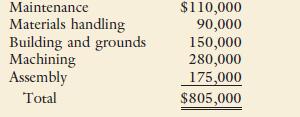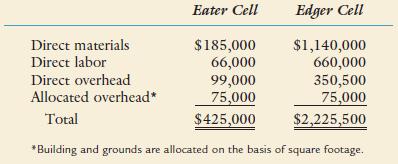Mott Company recently implemented a JIT manufacturing system. After one year of operation, Heidi Burrows, president of
Question:
Mott Company recently implemented a JIT manufacturing system. After one year of operation, Heidi Burrows, president of the company, wanted to compare product cost under the JIT system with product cost under the old system. Mott’s two products are weed eaters and lawn edgers. The unit prime costs under the old system are as follows:

Under the old manufacturing system, the company operated three service centers and two production departments. Overhead was applied using departmental overhead rates.
The direct overhead costs associated with each department for the year preceding the installation of JIT are as follows:

Under the old system, the overhead costs of the service departments were allocated directly to the producing departments and then to the products passing through them.
(Both products passed through each producing department.) The overhead rate for the machining department was based on machine hours, and the overhead rate for assembly was based on direct labor hours. During the last year of operations for the old system, the machining department used 80,000 machine hours, and the assembly department used 20,000 direct labor hours. Each weed eater required one machine hour in machining and 0.25 direct labor hour in assembly. Each lawn edger required two machine hours in machining and 0.5 hour in assembly. Bases for allocation of the service costs are as follows:

Upon implementing JIT, a manufacturing cell for each product was created to replace the departmental structure. Each cell occupied 40,000 square feet. Maintenance and materials handling were both decentralized to the cell level. Essentially, cell workers were trained to operate the machines in each cell, assemble the components, maintain the machines, and move the partially completed units from one point to the next within the cell. During the first year of the JIT system, the company produced and sold 20,000 weed eaters and 30,000 lawn edgers. This output was identical to that for the last year of operations under the old system. The following costs have been assigned to the manufacturing cells:

Required:
1. Compute the unit cost for each product under the old manufacturing system.
2. Compute the unit cost for each product under the JIT system.
3. Which of the unit costs is more accurate? Explain. Include in your explanation a discussion of how the computational approaches differ.
4. Calculate the decrease in overhead costs under JIT, and provide some possible reasons that explain the decrease.
Step by Step Answer:

Cost Management Accounting And Control
ISBN: 9780324233100
5th Edition
Authors: Don R. Hansen, Maryanne M. Mowen





